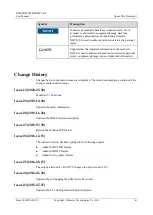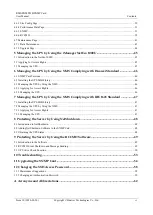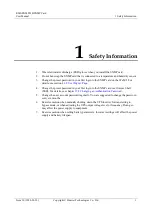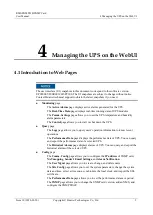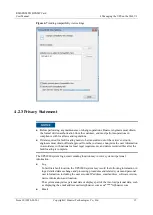
RMS-SNMP01B SNMP Card
User Manual
2 Overview
Issue 10 (2020-03-20)
Copyright © Huawei Technologies Co., Ltd.
2
2
Overview
2.1 Functions
The SNMP card is an optional monitoring component of the UPS. It provides SNMP agent
and web management functions. The SNMP card allows users to remotely manage the UPS by
using an NMS, Huawei NetEco, or a web browser on a computer network. A maximum of 16
SNMPv3 users and 80 NMS users can manage the UPS. A maximum of 2 WebUI users can
manage the UPS online.
The SNMP card has an exquisite, advanced, and unique design, and features high
performance and reliability. It has the following functions and features:
Supports UPS2000-A-(1 kVA-3 kVA) and UPS2000-G-(1 kVA-3 kVA) series.
Adapts to the 10 Mbit/s, 100 Mbit/s fast Ethernet (FE).
Supports SNMP, HTTPS, and SSH.
Supports SNMP agent v1, v2c, and v3. The UPS MIB library can be downloaded from
its own web page, instead of any CD-ROM.
Supports remote management on Windows or Linux using a web browser. The supported
web browsers include Internet Explorer 8, Internet Explorer 9, Internet Explorer 10,
Internet Explorer 11, Firefox 33.1, and Chrome 39.0.2171.71.
Provides an access security mechanism, assigns rights to users based on roles, and
implements IP address control over HTTPS, SNMPv3, and SNMP access to prevent
unauthorized access.
Provides comprehensive UPS management, such as producing an energy flow diagram,
displaying alarms, controlling UPS running, collecting performance data statistics, as
well as allowing users to view, retrieve historical alarms and operation logs.
Supports optional environment monitoring components such as temperature and
humidity modules, and external dry contact card.
Works with NetShutdown, a computer and server security shutdown program developed
by Huawei, to automatically shut down the computers and servers where NetShutdown is
installed to protect customer data and reduce loss.
Works with RCCMD, a client shutdown software developed by Generex, to
automatically and safely shut down the client that is installed with the RCCMD, thereby
protecting customers' data and preventing loss.
Alarm information is sent to the specified user mailbox at the specified time.




